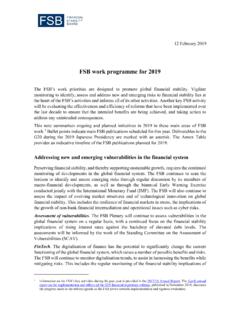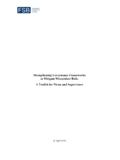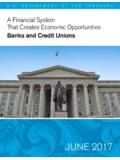Transcription of Basel Committee on Banking Supervision Board of the ...
1 Basel Committeeon Banking Supervision Board of the international organization of securities Commissions Margin requirements for non-centrally cleared derivatives September 2013 A revised document was issued in March 2015. revised document was issued in March 2015. This publication is available on the BIS website ( ) and IOSCO website ( ). Bank for international Settlements 2013. All rights reserved. Brief excerpts may be reproduced or translated provided the source is stated. ISBN 92-9131-941-4 (print) ISBN 92-9197-941-4 (online) A revised document was issued in March 2015. revised document was issued in March 2015.
2 Requirements for non-centrally cleared derivatives Contents Part A: Executive summary .. 1 Part B: Key principles and requirements .. 6 Element 1: Scope of coverage instruments subject to the requirements .. 6 Element 2: Scope of coverage scope of applicability .. 7 Element 3: Baseline minimum amounts and methodologies for initial and variation margin .. 10 Element 4: Eligible collateral for margin .. 16 Element 5: Treatment of provided initial margin .. 18 Element 6: Treatment of transactions with affiliates .. 21 Element 7: Interaction of national regimes in cross-border transactions .. 22 Element 8: Phase-in of requirements .. 23 Appendix A .. 25 Standardised initial margin schedule.
3 25 Appendix B .. 26 Standardised haircut schedule .. 26 A revised document was issued in March 2015. revised document was issued in March 2015. requirements for non-centrally cleared derivatives Abbreviations BCBS Basel Committee on Banking Supervision BIS Bank for international Settlements CCP Central counterparty CGFS Committee on the Global Financial System CPSS Committee on Payment and Settlement Systems FSB Financial Stability Board FX Foreign exchange G20 The Group of Twenty G-SIFI Global systemically important financial institution IOSCO
4 international organization of securities Commissions LCR Liquidity coverage ratio MTA Minimum transfer amount NSFR Net stable funding ratio OTC Over-the-counter PSE Public Sector Entity QIS Quantitative impact study WGMR Working Group on Margining Requirements A revised document was issued in March 2015.
5 Revised document was issued in March 2015. requirements for non-centrally cleared derivatives 1 Part A: Executive summary This document presents the final policy framework that establishes minimum standards for margin requirements for non-centrally cleared derivatives as agreed by the Basel Committee on Banking Supervision (BCBS) and the international organization of securities Commissions (IOSCO).1 This final framework was developed in consultation with the Committee on Payment and Settlement Systems (CPSS) and the Committee on the Global Financial System (CGFS). Background The economic and financial crisis that began in 2007 exposed significant weaknesses in the resiliency of banks and other market participants to financial and economic shocks.
6 In the context of over-the-counter (OTC) derivatives in particular, the recent financial crisis demonstrated that improved transparency in the OTC derivatives markets and further regulation of OTC derivatives and market participants would be necessary to limit excessive and opaque risk-taking through OTC derivatives and to mitigate the systemic risk posed by OTC derivatives transactions, markets, and practices. In response, the Group of Twenty (G20) initiated a reform programme in 2009 to reduce the systemic risk from OTC derivatives. As initially agreed in 2009, the G20 s reform programme comprised four elements: All standardised OTC derivatives should be traded on exchanges or electronic platforms, where appropriate.
7 All standardised OTC derivatives should be cleared through central counterparties (CCPs). OTC derivatives contracts should be reported to trade repositories. Non-centrally cleared derivatives contracts should be subject to higher capital In 2011, the G20 agreed to add margin requirements on non-centrally cleared derivatives to the reform programme and called upon the BCBS and IOSCO to develop, for consultation, consistent global standards for these margin To this end, the BCBS and IOSCO, in consultation with the CPSS and CGFS, formed the Working Group on Margining Requirements (WGMR) in October 2011 to develop a proposal on margin requirements for non-centrally cleared derivatives for consultation by mid-2012.
8 In July 2012, an initial proposal was released for consultation. The initial proposal was followed by an invitation to comment on the proposal by 28 September 2012. Additionally, a quantitative impact study (QIS) was conducted to assess the potential liquidity and other quantitative impacts associated with mandatory margining requirements. 1 Throughout this paper, the term non-centrally cleared derivatives is used as shorthand to refer to derivatives that are not cleared through a central counterparty. 2 G20, Pittsburgh summit declaration, 3 G20, Cannes summit final declaration, A revised document was issued in March 2015. Margin requirements for non-centrally cleared derivatives In February 2013, the BCBS and IOSCO released a second consultative document that reflected the near-final policy framework after careful consideration of the responses to the first consultative document as well as the QIS results.
9 The consultative document sought comment on four questions relating to certain specific aspects of the near-final margin framework. A large number of comments were received on the near-final margin framework. These comments have been considered in updating the proposal and specifying a final global framework for margining requirements on non-centrally cleared derivatives. The following document lays out the key objectives, elements and principles of the final margining framework for non-centrally cleared derivatives. Objectives of margin requirements for non-centrally cleared derivatives Margin requirements for non-centrally cleared derivatives have two main benefits: Reduction of systemic risk.
10 Only standardised derivatives are suitable for central clearing. A substantial fraction of derivatives are not standardised and cannot be centrally These non-centrally cleared derivatives, totalling hundreds of trillions of dollars in notional amounts,5 pose the same type of systemic contagion and spillover risks that materialised in the recent financial crisis. Margin requirements for non-centrally cleared derivatives would be expected to reduce contagion and spillover effects by ensuring that collateral is available to offset losses caused by the default of a derivatives counterparty. Margin requirements can also have broader macroprudential benefits, by reducing the financial system s vulnerability to potentially destabilising procyclicality and limiting the build-up of uncollateralised exposures within the financial system.

















